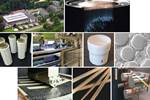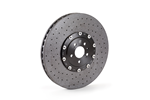ARIS introduces polymer-free ceramic composite
Fireproof, lightweight ceramic material ALEC2 is highly sustainable, suitable for manufacturing a variety of aerospace products, as well as marine and other industries.
Photo Credit: ARIS
(ARIS, Greensboro, N.C., U.S.), in collaboration with business development company WT&C (Alberta, Canada), announces the development of ALEC2, a patent-pending ceramic material that is 100% sustainable, fireproof, lightweight and polymer-free. It is suitable for manufacturing a variety of aerospace products such as sandwich panel and cargo liner components, and is flexible for use in marine and other end markets.
is comprised of ~85% eco-friendly industrial mineral waste, is completely recyclable and reduces the carbon footprint associated with aerospace composites manufacturing, according to ARIS. With safety paramount to this industry, the ceramic material is engineered to be fireproof, not just fire-resistant, with low thermal conductivity, contributing to increasing crew and passenger safety while significantly reducing the impact and risks of in-flight fire events. This characteristic is further aided by the materials entirely polymer-free nature, eliminating the release of toxic fumes in the event of fire.
ALEC2 is said to be lightweight, even more so in comparison to aluminum and polymer-based composites — approximately 1/5 the density of aluminum and 1/3 the density of carbon fiber-reinforced epoxy. It has a softening temperature of ~1,000°C, compression strength of 750-1,000 psi and flexure strength of 450 psi. ALEC2 can be nailed, machined and bonded and molded to very complex shapes.
ARIS anticipates that this new material will have far-reaching implications across the aerospace materials industry.
Contact Bill Hayward for further performance data and commercial opportunities for ALEC2 via email (alec2.com) or phone (403-608-2449).
Related Content
-
Carbon fiber, bionic design achieve peak performance in race-ready production vehicle
Porsche worked with Action Composites to design and manufacture an innovative carbon fiber safety cage option to lightweight one of its series race vehicles, built in a one-shot compression molding process.
-
Development of a composite liquid hydrogen tank for commercial aircraft
Netherlands consortium advances cryogenic composites testing, tank designs and manufacturing including AFP, hybrid winding, welding of tank components and integrated SHM and H2 sensors for demonstrators in 2025.
-
Bladder-assisted compression molding derivative produces complex, autoclave-quality automotive parts
HP Composites’ AirPower technology enables high-rate CFRP roof production with 50% energy savings for the Maserati MC20.






